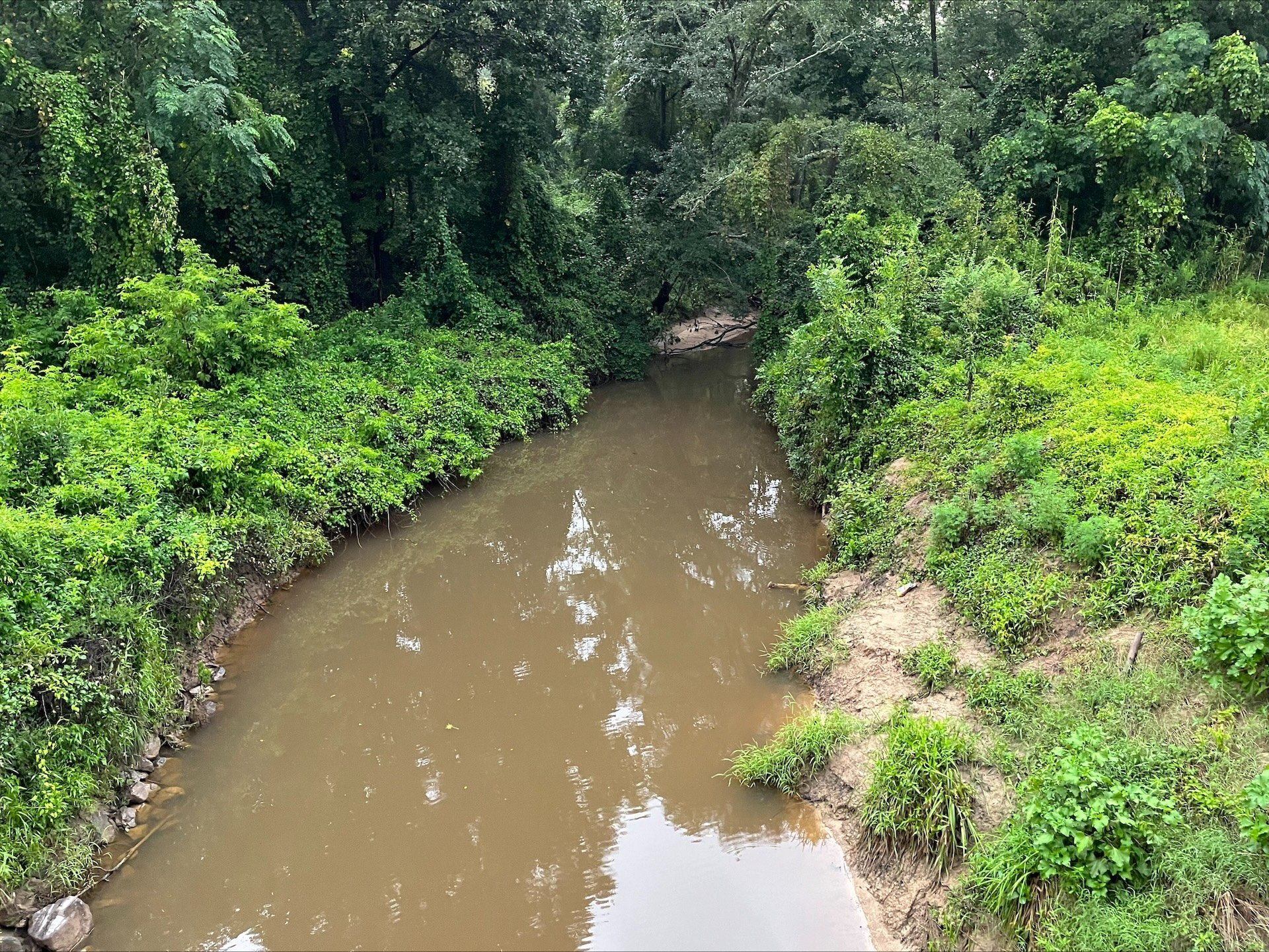
Counties with the shortest life expectancy in Mississippi
Life expectancy can be affected by a variety of factors. About 25% of your lifespan is determined by genetics, according to the National Library of Medicine. Health and wellness habits—like following a balanced, nutrient-rich diet; not smoking; drinking minimal alcohol; maintaining a healthy weight; and staying physically active—can add more than a decade to your life, research from the National Institutes of Health shows. While these factors are significant, another important element that you might not have considered is your environment and community.
While life expectancy generally increases annually in the United States—jumping from about 70.8 years old to 77.5 between 1970 and 2022, according to the Centers for Disease Control and Prevention—this particular metric can vary from state to state or even county to county. In some parts of the country, the average lifespan is getting shorter based on a variety of risk factors on top of health, including socioeconomic factors like poverty, unemployment, income, and education.
According to a 2020 study from researchers at Penn State, West Virginia, and Michigan State Universities, communities with a higher population density, more fast food restaurants, and a high number of extraction industry-based jobs tend to have shorter life expectancies.
To find out how life expectancy varies within Mississippi, Stacker used 2024 County Health Rankings & Roadmaps from the University of Wisconsin Population Health Institute to identify the counties with the shortest life expectancy. Life expectancy measures the average number of years from birth a person can expect to live and is calculated based on the number of deaths in a given time period and the average number of people at risk of dying during that period. Counties with unreliable or insufficient data were excluded from the analysis. Mortality data came from the National Vital Statistics System.
Read on to see if your county is on the list.
You may also like: Seniors in these Mississippi counties have the highest Alzheimer’s rates

#39. Yazoo County (tie)
– Life expectancy: 71.8 years
— 0.7 years lower than the state average

About
Yazoo County in central Mississippi has long been tied to agriculture, with cotton, soybeans, and timber driving much of its economy. Yazoo City acts as the hub for trade, linking farm operations with poultry production, small-scale manufacturing, and regional services.
The county’s identity remains rooted in farming, reinforced by local fairs and markets, while newer growth in distribution and transportation broadens opportunities. This blend of traditional agriculture and gradual diversification gives Yazoo County a steady economic rhythm.
Where is Yazoo County?
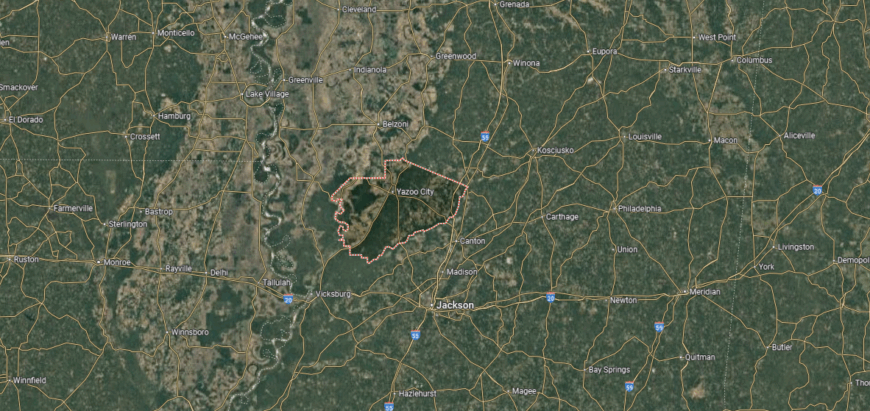
Yazoo County is located in west-central Mississippi, stretching from the Delta lowlands into the rolling hills that rise toward the capital region. The county seat, Yazoo City, sits about 40 miles northwest of Jackson and is reached by U.S. Highway 49 and Highway 3.
The landscape shifts from fertile farmland along the Yazoo River to wooded ridges and small towns scattered across the countryside. With its blend of river valley and upland terrain, Yazoo County feels both connected to Mississippi’s heartland and quietly set apart in its own landscape.
#39. Attala County (tie)
– Life expectancy: 71.8 years
— 0.7 years lower than the state average

About
Attala County in north-central Mississippi draws its economic strength from a mix of agriculture, forestry, and light manufacturing. Kosciusko, the county seat, serves as the commercial center where farming operations meet retail, health care, and service industries that support the wider community. Poultry and timber remain steady contributors, while smaller industrial employers provide a layer of stability beyond agriculture.
Community activity often ties back to its workforce, with schools, churches, and civic groups creating a network of support for local families. Economic growth has been gradual, shaped by the balance between traditional industries and emerging opportunities in services and small business. Attala County reflects a rural economy adapting carefully while preserving its long-standing roots.
Where is Attala County?
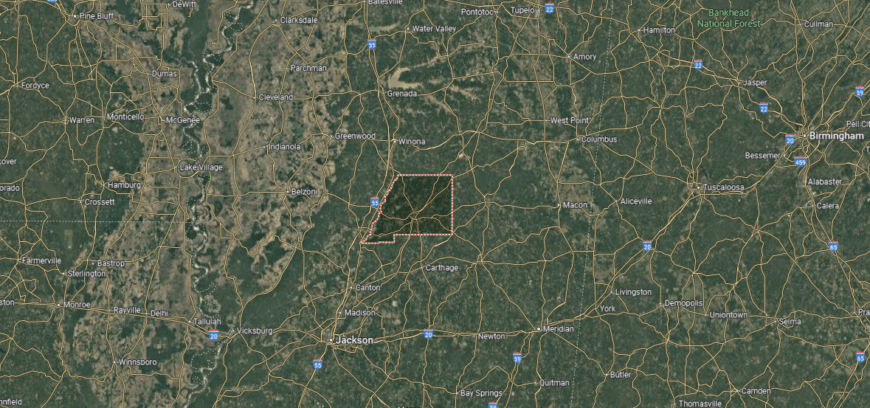
Attala County is in central Mississippi, stretching across wooded hills and farmland. Its county seat, Kosciusko, sits about 70 miles northeast of Jackson. The area is reached by State Highway 12 and the Natchez Trace Parkway, which cross directly through the county.
Surrounded by forest and rolling countryside, Attala County feels firmly set in the state’s heartland.
#37. Simpson County (tie)
– Life expectancy: 71.7 years
— 0.8 years lower than the state average

About
Simpson County, located in central Mississippi, maintains an economy led by agriculture, with poultry, cattle, and row crops forming the foundation of local production. The county seat, Mendenhall, supports the region with retail, small businesses, and access to transportation routes that connect to larger markets.
Local life is supported by schools, churches, and community events that bring residents together. In recent years, light manufacturing and service-related jobs have complemented traditional farming, giving Simpson County a mix of rural stability and measured economic growth.
Where is Simpson County?
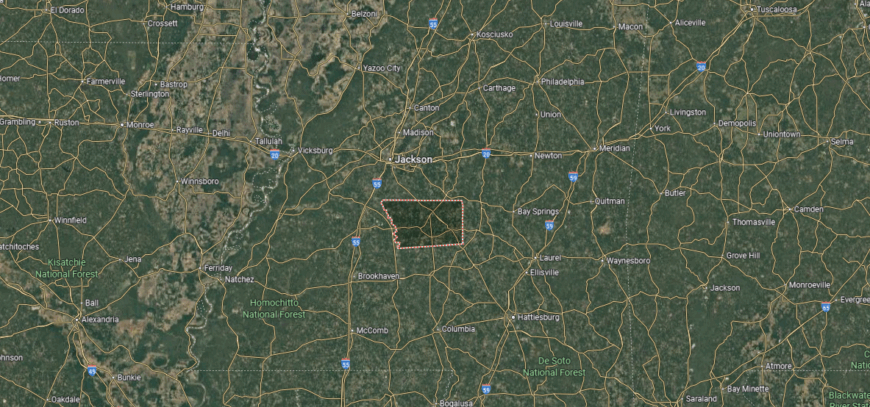
Simpson County is in south-central Mississippi, bordered by pine forests and farmland that stretch across gentle hills. The county seat, Mendenhall, lies about 30 miles south of Jackson along U.S. Highway 49.
Smaller roads branch out through rural communities, connecting farms, creeks, and woodlands. With its central location and quiet landscape, Simpson County sits as a rural crossroads in the state’s southern interior.
#37. Panola County (tie)
– Life expectancy: 71.7 years
— 0.8 years lower than the state average

About
Panola County in northwestern Mississippi supports a diverse economy rooted in agriculture, manufacturing, and distribution. The area’s farmland produces crops such as soybeans, corn, and cotton, while Batesville and Sardis serve as economic centers with growing retail and industrial activity. Proximity to major highways has also made the county a hub for transportation and warehousing.
Beyond its economic base, Panola County benefits from its location near Sardis Lake, which attracts visitors for fishing, boating, and outdoor recreation. Community life blends small-town traditions with opportunities tied to industry and tourism, giving the county both stability and room for future development.
Where is Panola County?

Panola County is set in the northwestern part of Mississippi, about 45 miles south of Memphis, Tennessee. It is anchored by two county seats, Batesville and Sardis, and is bisected by Interstate 55, making it a key crossroads in the region.
The county lies in the fertile Mississippi Delta, with farmland stretching across flat plains, forests, and the nearby Sardis Lake, a popular spot for fishing and boating. Its blend of agriculture, small-town charm, and proximity to larger cities gives Panola County a distinct balance of rural peace and regional connection.
#35. Lauderdale County (tie)
– Life expectancy: 71.6 years
— 0.9 years lower than the state average
You may also like: Best private high schools in Mississippi

About
Lauderdale County in eastern Mississippi centers its economy on healthcare, manufacturing, and retail. Meridian, the county seat, anchors the area with hospitals, clinics, aerospace facilities, and distribution tied to major transportation routes.
The county’s cultural heritage and historic landmarks support tourism, while schools and workforce programs strengthen its labor base. This mix of industry, services, and community assets provides steady economic footing.
Where is Lauderdale County?
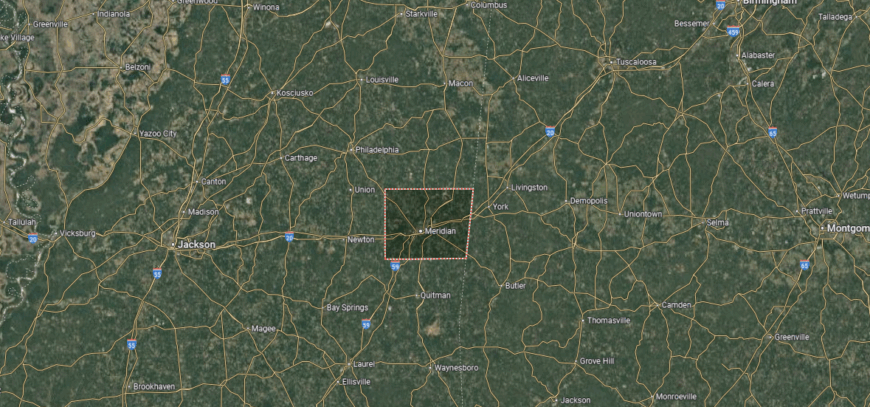
Lauderdale County sits along Mississippi’s eastern border with Alabama, anchored by Meridian, the county seat and largest city. Major routes like Interstate 20/59 and U.S. Highways 11 and 45 pass through the county, linking it to Jackson to the west and Birmingham, Alabama, to the east.
The landscape features rolling hills, pine forests, and streams, with Okatibbee Lake offering opportunities for fishing and recreation. Its position on key transportation lines has long made Lauderdale County a gateway between central Mississippi and the deeper South.
#35. Benton County (tie)
– Life expectancy: 71.6 years
— 0.9 years lower than the state average

About
Benton County in northern Mississippi maintains an economy rooted in agriculture and forestry, with cattle, row crops, and timber forming its base. Ashland, the county seat, supports small-scale manufacturing, retail, and service industries, aided by highway access that links the county to regional markets.
Local life is closely tied to its rural character, strengthened by schools, churches, and community events. While growth has been modest, new opportunities in trade and services complement farming and forestry, giving Benton County a measured but balanced economy.
Where is Benton County?
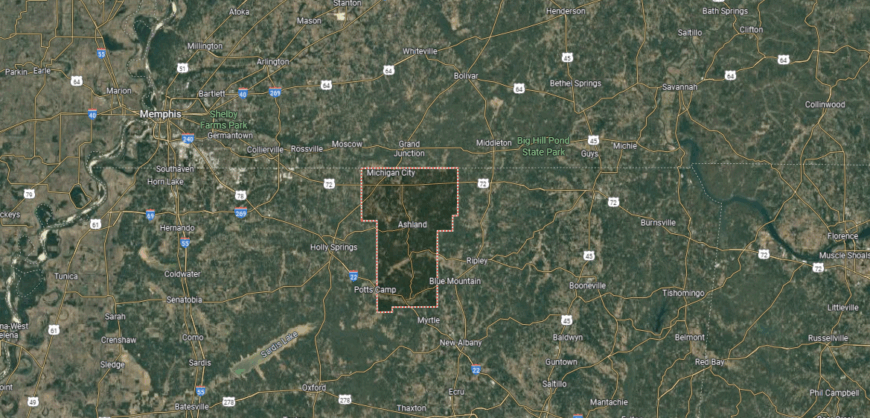
Benton County is a small, rural county in northern Mississippi, bordering Tennessee to the north. Its county seat is Ashland, a quiet community surrounded by forested hills, pastures, and farmland.
Major routes like U.S. Highway 72 and State Highway 4 provide connections to nearby towns and to larger cities such as Memphis, Tennessee, about 50 miles northwest. Tucked into the rolling hills of North Mississippi, Benton County feels like a peaceful retreat while still being within reach of urban centers.
#33. Stone County (tie)
– Life expectancy: 71.5 years
— 1.0 years lower than the state average

About
Stone County in southern Mississippi builds much of its economy on forestry, poultry farming, and small-scale agriculture. Wiggins, the county seat, supports these industries with retail, education, and health services, while its location along major highways makes it a link between coastal markets and inland communities.
Community activity reflects both rural traditions and the county’s growing role in tourism, with De Soto National Forest drawing visitors for outdoor recreation. Together, natural resources, local businesses, and service industries keep Stone County’s economy steady while offering space for gradual development.
Where is Stone County?
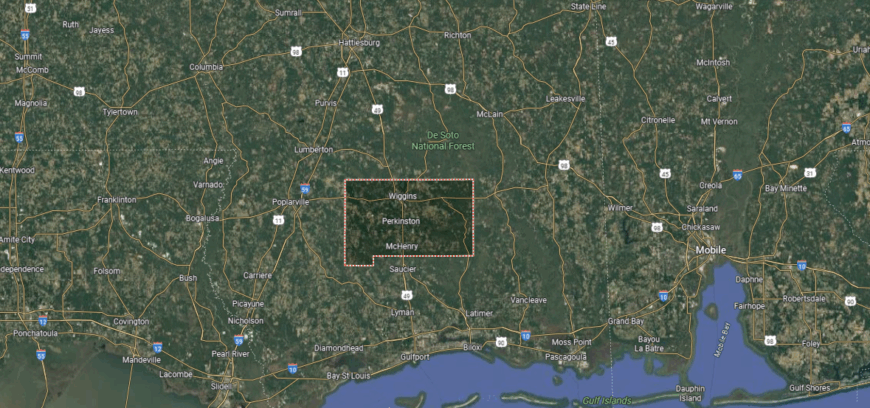
Stone County is located in southern Mississippi, set between the Gulf Coast and the Pine Belt region. The county seat, Wiggins, lies about 35 miles north of Gulfport and is reached by U.S. Highway 49, the main route running through the area.
The landscape is marked by pine forests, creeks, and stretches of farmland that define its rural setting. With its position between the coast and the interior, Stone County feels like a quiet crossroads tied to both regions.
#33. Lincoln County (tie)
– Life expectancy: 71.5 years
— 1.0 years lower than the state average

About
Lincoln County in southwest Mississippi balances an economy of agriculture, timber, and light manufacturing. Brookhaven, the county seat, serves as a regional center with retail, health care, and small industries that support the surrounding rural communities. Poultry farming and forestry remain steady contributors, while transportation access strengthens trade and distribution.
Community life is grounded in schools, churches, and civic events that connect residents across the county. With a mix of traditional farming and diversified services, Lincoln County maintains a stable economic base while adapting to gradual growth.
Where is Lincoln County?
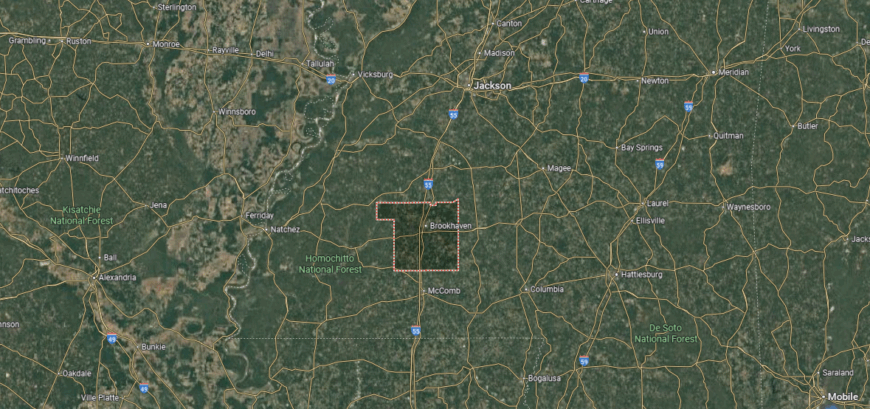
Lincoln County lies in southwestern Mississippi, with gently rolling hills and stretches of pine forest shaping its landscape. The county seat, Brookhaven, sits about 60 miles south of Jackson along Interstate 55.
Smaller highways and backroads branch out into rural communities, farmland, and wooded countryside. With its central location in the southwest region, Lincoln County feels like a hub between Mississippi’s capital and its southern towns.
#31. Lawrence County (tie)
– Life expectancy: 71.4 years
— 1.1 years lower than the state average

About
Lawrence County in south Mississippi sustains its economy through agriculture and forestry, with poultry, cattle, and timber leading local production. Monticello, the county seat, supports these sectors through retail, small trade networks, and access to regional transportation routes that link the county to larger markets.
Light manufacturing and service jobs add another layer to the economic mix, creating stability alongside the county’s farm and timber base. With steady resource use and gradual industrial growth, Lawrence County maintains a consistent economy while adapting to changing regional demands.
Where is Lawrence County?
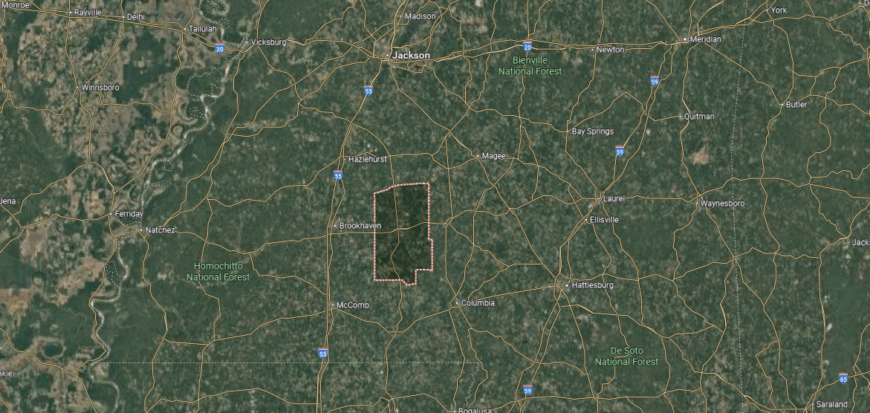
Lawrence County is in south-central Mississippi, with the Pearl River running along its western edge. The county seat, Monticello, lies about 60 miles south of Jackson and is reached by U.S. Highway 84, a main route cutting across the region.
The area is defined by pine forests, farmland, and river bottoms that give it a distinctly rural character. With its river setting and quiet countryside, Lawrence County sits as a calm stretch between larger towns to the east and west.
#31. Tallahatchie County (tie)
– Life expectancy: 71.4 years
— 1.1 years lower than the state average
You may also like: The most popular poker players in Mississippi

About
Tallahatchie County in the Mississippi Delta has long depended on agriculture, with cotton, soybeans, and corn forming the backbone of its economy. Charleston and Sumner, its two county seats, support local trade and provide links to processing, storage, and distribution that connect farm output to wider markets.
In addition to farming, forestry and small-scale manufacturing contribute to the county’s stability, while transportation access helps maintain regional commerce. With its mix of crops, timber, and industry, Tallahatchie County continues to reflect the Delta’s agricultural strength while building modest economic diversity.
Where is Tallahatchie County?
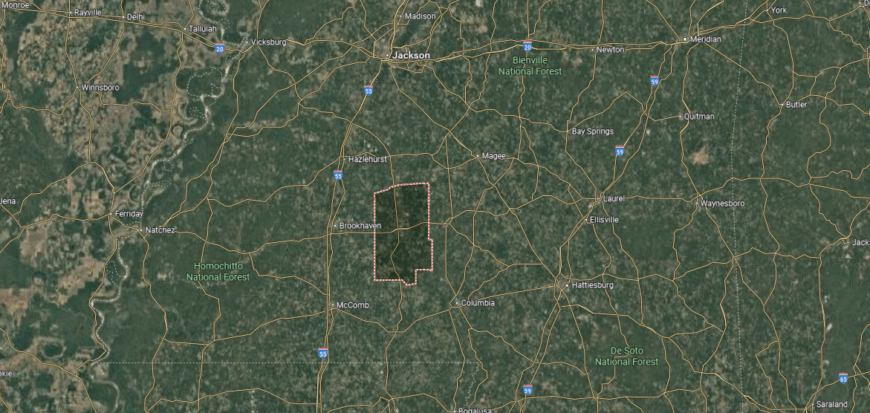
Tallahatchie County is in the Mississippi Delta region of northwestern Mississippi, where flat farmland stretches across the landscape. The county has two seats, Charleston in the east and Sumner in the west, both connected by U.S. Highway 49E and nearby rural routes.
The area lies about 40 miles south of Clarksdale and is framed by the Tallahatchie River, which winds through its fields and small towns. With its wide delta plains and quiet roads, Tallahatchie County sits firmly in the heart of Mississippi’s agricultural country.
#30. Pearl River County
– Life expectancy: 71.3 years
— 1.2 years lower than the state average

About
Pearl River County in south Mississippi supports a diverse economy built on forestry, poultry, and small-scale manufacturing. Poplarville, the county seat, plays a central role in trade and education, while nearby Picayune adds strength through retail, health care, and service industries.
The county’s location along major highways and rail lines has encouraged growth in distribution and logistics, broadening opportunities beyond traditional resource use. With forestry, farming, services, and transport working together, Pearl River County maintains a balanced and steadily adapting economy.
Where is Pearl River County?
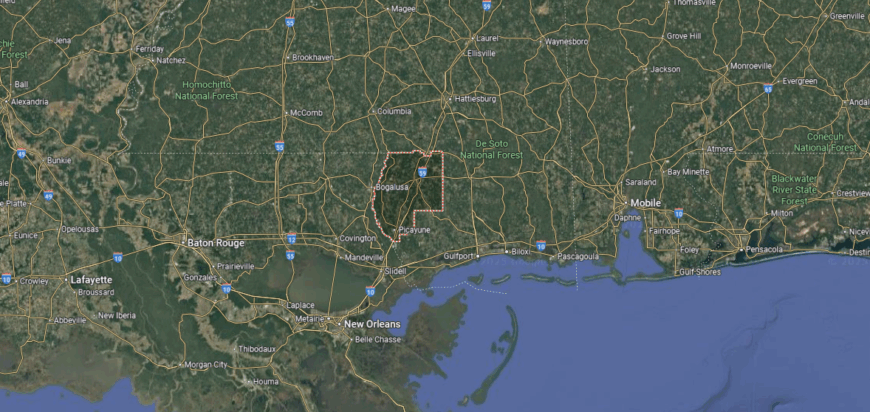
Pearl River County is in southern Mississippi, bordering Louisiana to the south. The county seat, Poplarville, lies about 70 miles north of New Orleans and 60 miles south of Hattiesburg, reached by Interstate 59.
The landscape blends pine forests, farmland, and the river bottoms of the Pearl River, which forms much of the county’s western edge. With its mix of rural countryside and cross-border connections, Pearl River County feels like a quiet but well-placed corner of the state.
#29. Calhoun County
– Life expectancy: 71.2 years
— 1.3 years lower than the state average

About
Calhoun County in north Mississippi maintains an economy shaped by agriculture, with sweet potatoes, poultry, and row crops driving much of its production. Bruce and Calhoun City, the county’s main centers, add strength through small industries, retail, and access to regional trade.
Forestry and light manufacturing contribute additional stability, while local food processing ties directly to its farming output. With agriculture at its core and industry supporting growth, Calhoun County balances tradition with steady economic development.
Where is Calhoun County?
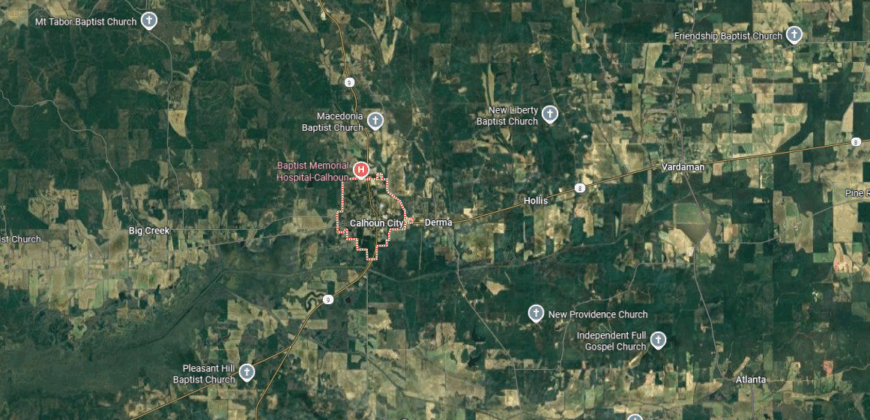
Calhoun County is located in north-central Mississippi, where rolling hills and forested ridges meet stretches of farmland. The county seat, Pittsboro, sits near the center of the county, with U.S. Highway 278 and State Highway 9 providing the main routes through the area.
It lies about 40 miles southwest of Oxford, placing it within reach of the college town while still feeling distinctly rural. Surrounded by small communities and countryside, Calhoun County holds the quiet character of Mississippi’s hill country.
#28. Noxubee County
– Life expectancy: 71.1 years
— 1.4 years lower than the state average

About
Noxubee County in eastern Mississippi relies heavily on agriculture, with soybeans, corn, and poultry forming the foundation of its production. Macon, the county seat, strengthens this base through trade, small industries, and access to regional transportation corridors that connect farms to broader markets.
Forestry and wood products contribute further, adding value to the county’s natural resources. Together with gradual growth in light manufacturing and services, Noxubee County sustains a steady economy that remains rooted in its agricultural and timber strengths.
Where is Noxubee County?
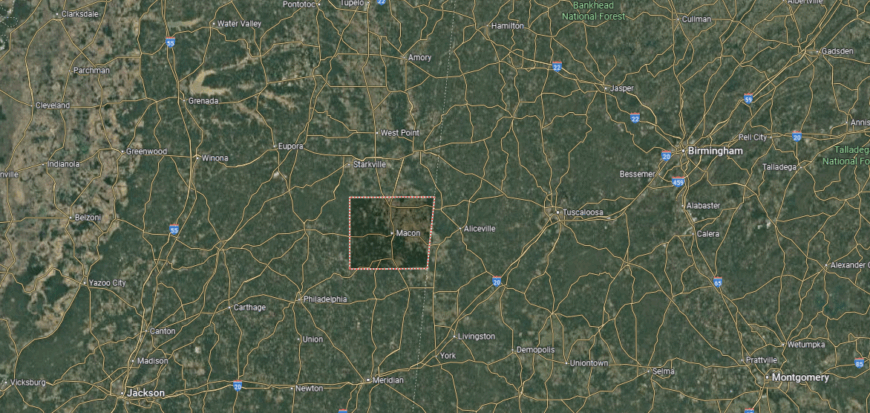
Noxubee County is in eastern Mississippi, bordering Alabama and set within a landscape of forests, farmland, and river bottoms. The county seat, Macon, lies along U.S. Highway 45, about 40 miles south of Columbus.
Smaller state highways branch through rural communities and toward the Noxubee National Wildlife Refuge, which covers much of the county’s southern area. With its mix of woodland and open fields, Noxubee County feels like a quiet stretch of countryside along the state line.
#27. Perry County
– Life expectancy: 71.0 years
— 1.5 years lower than the state average

About
Perry County in south Mississippi builds its economy around forestry, poultry farming, and small-scale agriculture. New Augusta, the county seat, anchors administration and trade, while Richton contributes through retail, small industries, and local business activity.
Sawmills and wood product operations remain important employers, supported by the county’s extensive timberlands. Alongside farming and light manufacturing, these industries provide Perry County with a steady, resource-based economy that continues to adapt to regional markets.
Where is Perry County?
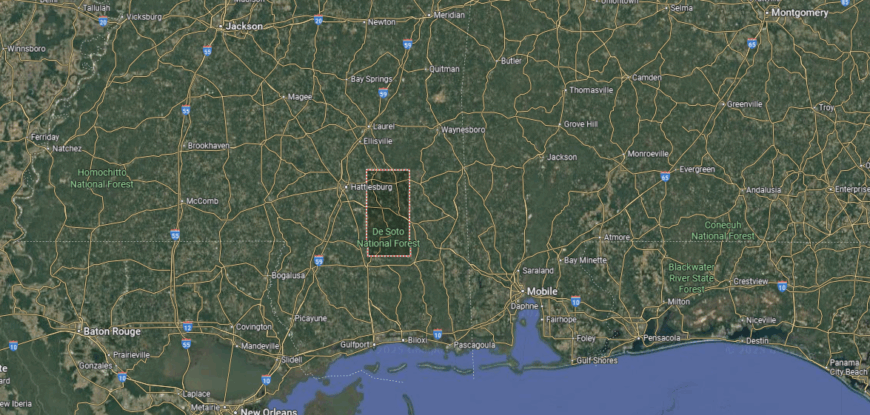
Perry County sits in south-central Mississippi, surrounded by rolling pine forests and crossed by the Leaf River. The county seat, New Augusta, is a small town located east of Hattiesburg, with U.S. Highway 98 providing the main east–west connection.
Outdoor enthusiasts are drawn to the De Soto National Forest, which offers hiking, camping, and birdwatching in a serene setting. With its natural beauty and peaceful rural atmosphere, Perry County feels like a tranquil escape from busier parts of the state.
#25. George County (tie)
– Life expectancy: 70.9 years
— 1.6 years lower than the state average
You may also like: Best counties to raise a family in Mississippi

About
George County in southeast Mississippi maintains a strong economy rooted in forestry, poultry, and row crop farming. Lucedale, the county seat, anchors trade, retail, and services, while connecting local producers to processing facilities and distribution networks across the region.
Its position near major highways and the Gulf Coast has supported growth in manufacturing, construction materials, and logistics, creating opportunities beyond agriculture. With forestry, farming, industry, and transportation working together, George County continues to strengthen its role as both a resource-based and regionally connected economy.
Where is George County?
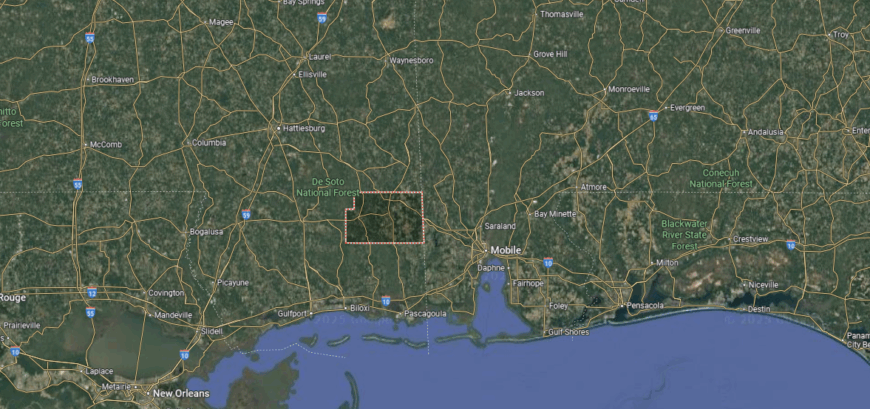
George County is in southeastern Mississippi, bordering Alabama and surrounded by pine forests and farmland. The county seat, Lucedale, sits about 40 miles northwest of Mobile, Alabama, and is reached by U.S. Highway 98.
State highways branch through small communities and connect to the Pascagoula River basin, which winds along the county’s western edge. With its mix of forest, river, and open land, George County holds the feel of a quiet border county tied to both Mississippi and the Gulf Coast.
#25. Jasper County (tie)
– Life expectancy: 70.9 years
— 1.6 years lower than the state average

About
Jasper County in east-central Mississippi relies on agriculture and forestry as the backbone of its economy, with poultry, cattle, and timber leading local production. Bay Springs, the county seat, supports these sectors with retail, trade, and small manufacturing that connect rural producers to regional markets.
The county also benefits from its industrial park and access to major highways, which have encouraged growth in manufacturing and distribution. By balancing its strong agricultural base with expanding industry, Jasper County maintains a steady and adaptable economy.
Where is Jasper County?
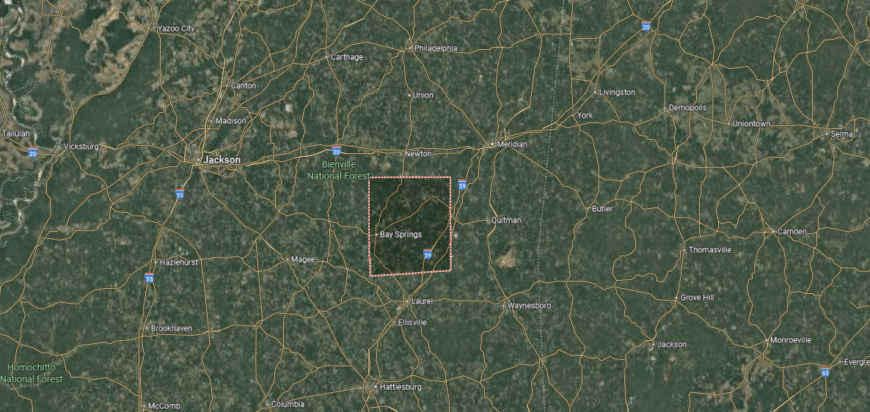
Jasper County is located in east-central Mississippi, with gently rolling hills, pine woods, and farmland shaping its landscape. The county has two seats, Bay Springs in the west and Paulding in the east, both connected by State Highway 18.
It lies about 40 miles east of Jackson, reached by Interstate 20, which passes just north of the county. With its mix of forests and rural communities, Jasper County sits as a quiet stretch between Mississippi’s capital region and the piney woods to the south.
#24. Tishomingo County
– Life expectancy: 70.8 years
— 1.7 years lower than the state average

About
Tishomingo County in northeast Mississippi supports a diversified economy that extends beyond its agricultural base. Corn, soybeans, and poultry remain important, but the county has also developed strong industrial sectors in automotive parts, furniture, and metal fabrication.
Iuka, the county seat, serves as the center for trade and services, while the Tennessee River and nearby transportation routes strengthen distribution and manufacturing. With farming, industry, and logistics working together, Tishomingo County maintains a balanced economy that connects rural resources with regional growth.
Where is Tishomingo County?
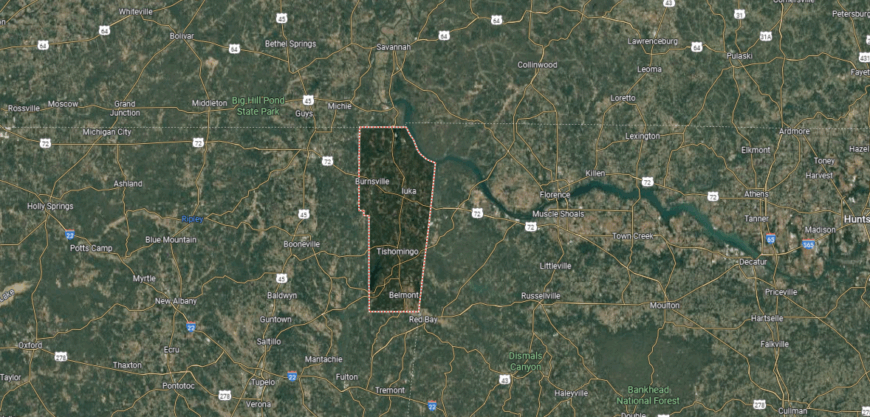
Tishomingo County is in the far northeastern corner of Mississippi, bordered by Tennessee to the north and Alabama to the east. The county seat, Iuka, is about 30 miles east of Corinth and is reached by U.S. Highway 72, a main east–west route.
The landscape is marked by the Tennessee River, Pickwick Lake, and the wooded hills of the Appalachian foothills. With its river valleys and tri-state location, Tishomingo County feels both connected and tucked into a scenic, secluded corner of Mississippi.
#22. Marshall County (tie)
– Life expectancy: 70.5 years
— 2.0 years lower than the state average

About
Marshall County in north Mississippi blends agriculture with a growing industrial base. Poultry, cattle, and row crops continue to shape the rural economy, while Holly Springs, the county seat, supports retail, trade, and light manufacturing.
The county’s proximity to Memphis and major highway corridors has fueled growth in warehousing, distribution, and manufacturing facilities. With farming still important but industry and logistics expanding, Marshall County maintains a steadily diversifying economy.
Where is Marshall County?
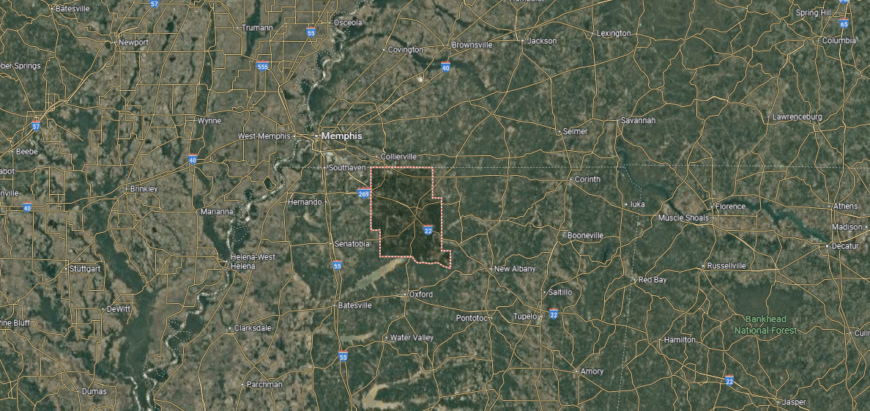
Marshall County is in northern Mississippi, bordering Tennessee and lying within the rolling hills of the state’s hill country. The county seat, Holly Springs, is about 35 miles southeast of Memphis and is reached by Interstate 22 and U.S. Highway 78.
The area blends farmland, forest, and small rural communities, with easy access to both countryside and urban centers. With its border location and historic town center, Marshall County feels like a crossroads between North Mississippi and West Tennessee.
#22. Newton County (tie)
– Life expectancy: 70.5 years
— 2.0 years lower than the state average

About
Newton County in east-central Mississippi maintains an economy grounded in poultry, cattle, and timber, with row crops adding to farm output. Newton and Decatur, its key towns, provide retail, trade, and small industries that support local producers.
Highway access has encouraged modest growth in distribution and manufacturing, linking the county to regional markets. With agriculture as its base and industry gradually expanding, Newton County sustains a balanced and reliable economy.
Where is Newton County?
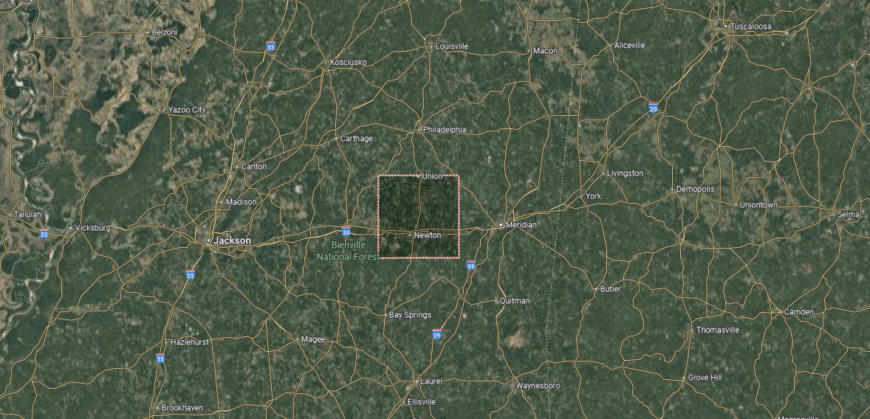
Newton County is in east-central Mississippi, with gently rolling hills and stretches of farmland and pine forest. The county seat, Decatur, lies about 65 miles east of Jackson and is reached by Interstate 20, which cuts across the northern part of the county.
Smaller state highways connect its rural communities, linking farmland, creeks, and wooded countryside. With its quiet landscape and central location, Newton County feels like a calm stretch of Mississippi’s interior.
#21. Webster County
– Life expectancy: 70.4 years
— 2.1 years lower than the state average
You may also like: Metros where renters are the most overextended in Mississippi

About
Webster County in north-central Mississippi relies on agriculture and forestry, with poultry, cattle, and timber forming the core of its economy. Eupora, the county seat, anchors trade and services, while small manufacturing adds further stability.
Its location along key highways supports movement of goods and access to regional markets, giving local producers broader reach. With farming, forestry, and light industry working together, Webster County maintains a steady and resource-based economy.
Where is Webster County?
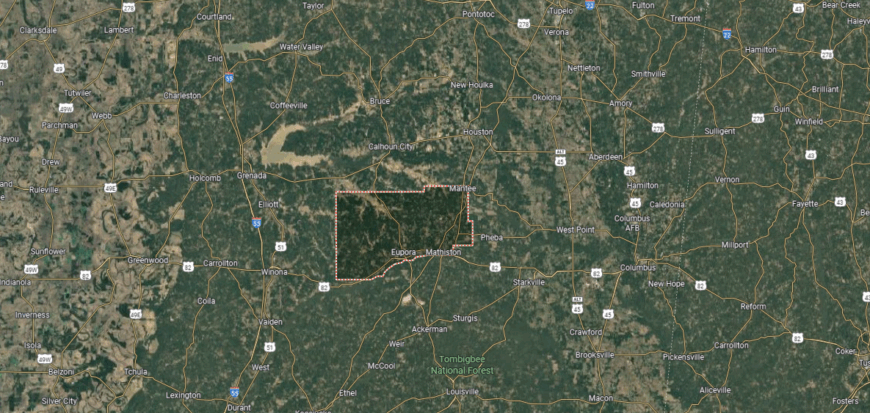
Webster County is in north-central Mississippi, set among the rolling hills and forests of the state’s interior. The county seat, Walthall, lies along State Highway 9, about 35 miles west of Starkville. U.S.
Highway 82 crosses the northern part of the county, providing a direct east–west connection to larger towns. With its wooded ridges, farmland, and small communities, Webster County holds the quiet feel of Mississippi’s hill country.
#19. Marion County (tie)
– Life expectancy: 70.3 years
— 2.2 years lower than the state average

About
Marion County in south Mississippi builds its economy on forestry, poultry farming, and cattle production, supported by row crops in surrounding farmland. Columbia, the county seat, anchors trade and small industries that process and distribute local resources.
Its position along major highways has encouraged development in manufacturing, retail, and distribution, widening the county’s economic base. With agriculture at its core and industry expanding, Marion County continues to balance rural production with regional growth opportunities.
Where is Marion County?
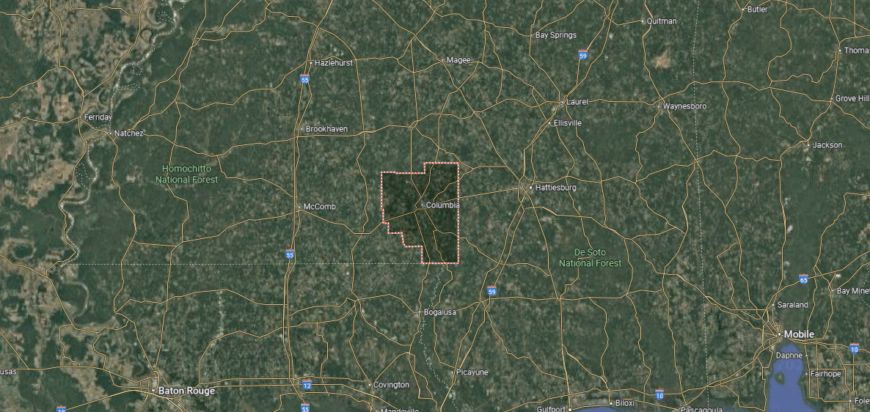
Marion County is in southern Mississippi, bordered by the Pearl River and covered with pine forests and farmland. The county seat, Columbia, sits about 30 miles west of Hattiesburg and is reached by U.S. Highway 98.
Smaller highways and rural roads connect its surrounding communities, winding through rolling countryside and river bottoms. With its mix of wooded hills and open fields, Marion County feels like a quiet stretch of Mississippi’s Pine Belt region.
#19. Pike County (tie)
– Life expectancy: 70.3 years
— 2.2 years lower than the state average

About
Pike County in southwest Mississippi supports a diverse economy that combines agriculture, manufacturing, and services. Poultry, cattle, and timber remain central, while McComb, the county seat, strengthens the area with retail, health care, and light industry.
Its location along Interstate 55 has made the county an important point for transportation and distribution, encouraging growth in logistics and commerce. With farming, services, and industry working together, Pike County maintains a balanced economy that connects rural resources with regional markets.
Where is Pike County?
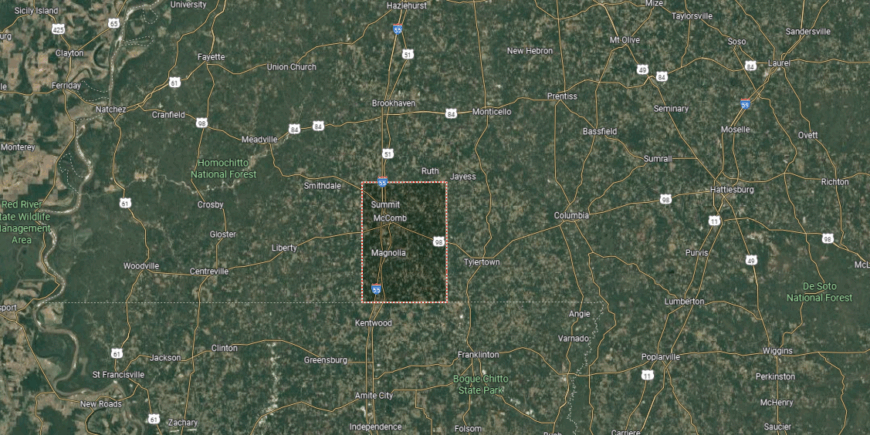
Pike County is in southwestern Mississippi, bordering Louisiana to the south. The county seat, Magnolia, lies along Interstate 55 about 75 miles south of Jackson and just north of McComb, the county’s largest city.
The area is crossed by U.S. Highways 51 and 98, linking it to nearby towns and the Louisiana line. With its position on major routes yet surrounded by farmland and pine woods, Pike County feels like a crossroads between Mississippi’s interior and the Gulf South.
#17. Wilkinson County (tie)
– Life expectancy: 70.0 years
— 2.5 years lower than the state average

About
Wilkinson County in southwest Mississippi relies on a resource-driven economy centered on forestry, cattle, and row crop farming. Woodville, the county seat, provides trade and small business activity, while the county’s location along the Mississippi River supports connections to broader markets.
Timber and related wood products remain important, alongside agriculture that continues to shape local output. With natural resources at its foundation and access to river trade routes, Wilkinson County sustains a steady economy rooted in land and transport.
Where is Wilkinson County?
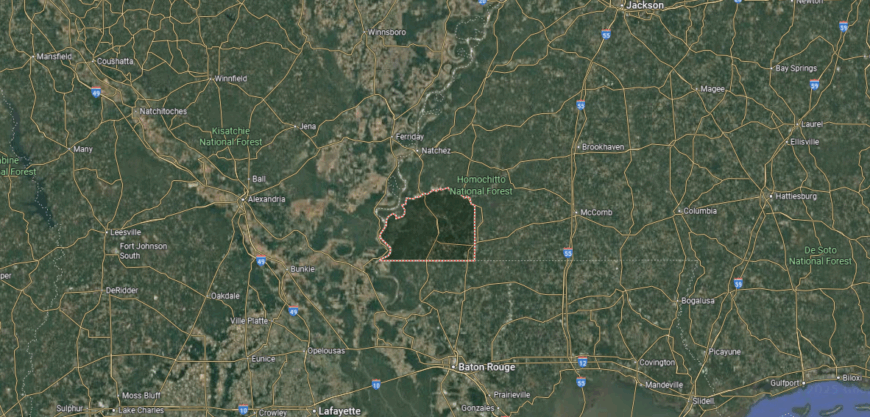
Wilkinson County is in the far southwestern corner of Mississippi, sharing its southern border with Louisiana along the Mississippi River. The county seat, Woodville, lies about 40 miles south of Natchez and is reached by U.S. Highway 61, a historic north–south route.
The landscape is a mix of wooded hills, river bottoms, and farmland, giving the area a distinctly rural feel. With its border location and quiet countryside, Wilkinson County feels like a secluded corner of the state tied closely to the river.
#17. Jefferson Davis County (tie)
– Life expectancy: 70.0 years
— 2.5 years lower than the state average

About
Jefferson Davis County in south Mississippi maintains an economy rooted in agriculture, with poultry, cattle, and timber forming its main base. Prentiss, the county seat, supports these sectors through retail, trade, and small business activity that ties rural production to regional markets.
While farming remains dominant, light manufacturing and service-related jobs have added some diversification. With steady agricultural output and gradual industrial growth, Jefferson Davis County continues to operate on a stable, land-based economy.
Where is Jefferson Davis County?
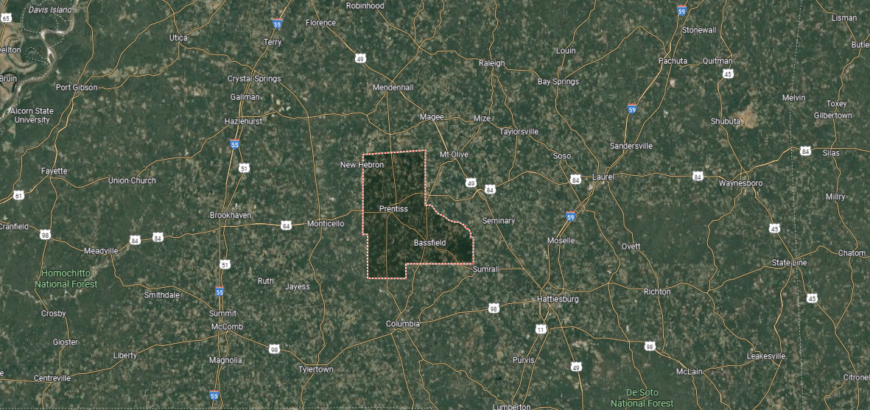
Jefferson Davis County is in south-central Mississippi, covered with pine forests, farmland, and small rural communities. The county seat, Prentiss, sits about 60 miles south of Jackson and is reached by U.S. Highway 84, which runs east–west across the county.
State Highway 13 also crosses through, connecting the area north and south through wooded countryside. With its quiet setting and crossroads location, Jefferson Davis County feels like a rural stretch set between Mississippi’s Pine Belt and Delta regions.
#16. Yalobusha County
– Life expectancy: 69.9 years
— 2.6 years lower than the state average
You may also like: Strawberries, romaine lettuce, and other groceries that rose in price in the South last month

About
Yalobusha County in north Mississippi balances agriculture with manufacturing as key parts of its economy. Poultry, cattle, and row crops remain steady, while Water Valley, the county seat, supports industry with food processing and small manufacturing facilities.
Forestry and transportation access add further stability, connecting local producers to wider markets. With farming, timber, and industry working together, Yalobusha County maintains a dependable economy rooted in both land and industry.
Where is Yalobusha County?

Yalobusha County is in north-central Mississippi, where rolling hills meet the flatlands of the Delta’s edge. The county has two seats, Water Valley and Coffeeville, both reached by State Highway 7 and U.S. Highway 51 nearby.
It lies about 25 miles south of Oxford, with roads winding through farmland, forest, and small rural communities. With its mix of hills, creeks, and open fields, Yalobusha County feels like a quiet transition between Mississippi’s highlands and delta country.
#15. Montgomery County
– Life expectancy: 69.8 years
— 2.7 years lower than the state average

About
Montgomery County in north-central Mississippi sustains its economy through agriculture, forestry, and light manufacturing. Poultry, cattle, and timber form the base, while Winona, the county seat, anchors retail, small industries, and regional trade.
Its position along Interstate 55 has made transportation and distribution important, linking local producers to larger markets. With farming, timber, and growing industrial activity, Montgomery County maintains a steady and adaptable economy.
Where is Montgomery County?

Montgomery County is in north-central Mississippi, set among rolling hills, creeks, and stretches of farmland. The county seat, Winona, lies along Interstate 55 about 90 miles north of Jackson, making it a key stop between central and northern parts of the state. U.S.
Highway 82 also crosses the county, providing an east–west connection through its small towns and countryside. With its wooded ridges and crossroads location, Montgomery County feels like a quiet but well-placed part of Mississippi’s interior.
#14. Claiborne County
– Life expectancy: 69.6 years
— 2.9 years lower than the state average

About
Claiborne County in southwest Mississippi maintains an economy tied to agriculture, forestry, and energy. Row crops, cattle, and timber remain important, while the Grand Gulf Nuclear Station near Port Gibson provides a major source of employment and revenue.
Port Gibson, the county seat, supports local trade and small business, with access to the Mississippi River strengthening transport and commerce. With its mix of farming, energy production, and river connections, Claiborne County sustains a distinctive and resource-based economy.
Where is Claiborne County?
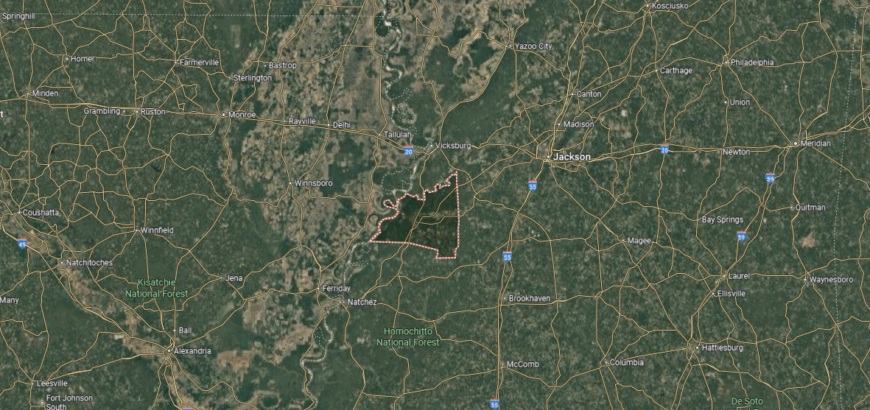
Claiborne County is in western Mississippi, bordered by the Mississippi River along its western edge. The county seat, Port Gibson, lies about 30 miles south of Vicksburg and is reached by U.S. Highway 61, a historic north–south route through the region.
The landscape combines river bluffs, rolling hills, and stretches of forest and farmland. With its riverfront setting and rural roads, Claiborne County feels like a quiet corner tucked between the Delta and the hill country.
#12. Covington County (tie)
– Life expectancy: 69.5 years
— 3.0 years lower than the state average

About
Covington County in south-central Mississippi relies on agriculture and forestry as the backbone of its economy, with poultry, cattle, and timber leading production. Collins, the county seat, anchors trade and services, while food processing and small industries add support to the farm sector.
Its location along key highways has also encouraged growth in distribution and light manufacturing. With farming, timber, and expanding industry working together, Covington County maintains a stable economy that links rural resources to regional markets.
Where is Covington County?
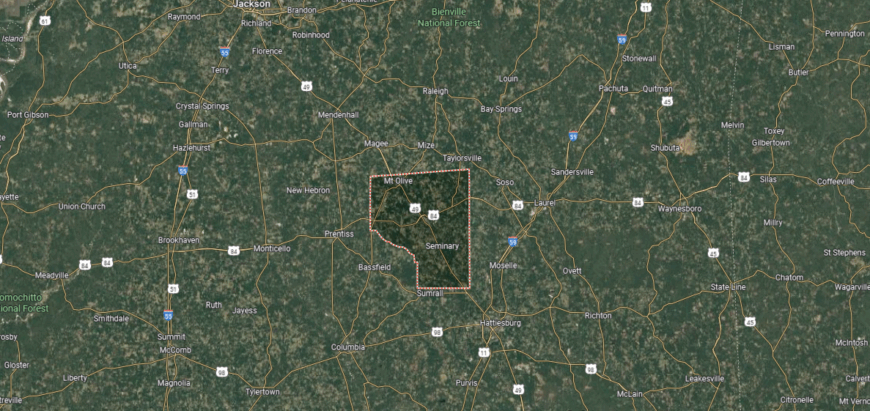
Covington County is in south-central Mississippi, where pine forests and farmland spread across gently rolling hills. The county seat, Collins, lies about 35 miles southeast of Jackson and is reached by U.S. Highway 49, the main north–south route through the county.
Smaller state highways branch out into rural communities and connect with nearby towns like Mount Olive and Seminary. With its quiet countryside and central location, Covington County feels like a settled stretch of Mississippi’s Pine Belt.
#12. Grenada County (tie)
– Life expectancy: 69.5 years
— 3.0 years lower than the state average

About
Grenada County in north-central Mississippi supports a mixed economy built on manufacturing, forestry, and agriculture. Grenada, the county seat, serves as a regional hub with industries in automotive parts, metal fabrication, and food processing, alongside poultry and timber production.
Interstate access and proximity to rail lines have made the county a strong location for distribution and logistics. With its combination of industry, natural resources, and transportation assets, Grenada County maintains a diverse and resilient economic base.
Where is Grenada County?

Grenada County is in north-central Mississippi, set between the hills of the north and the flatlands of the Delta. The county seat, Grenada, sits along Interstate 55 about 100 miles south of Memphis, making it a key stop between northern and central Mississippi. U.S.
Highway 51 and State Highway 8 also cross the county, linking small communities, farmland, and forested areas. With its blend of Delta plains, wooded hills, and Grenada Lake nearby, the county feels like a crossroads of landscapes in the state’s interior.
#11. Sharkey County
– Life expectancy: 68.5 years
— 4.0 years lower than the state average
You may also like: Best public high schools in Mississippi

About
Sharkey County in the Mississippi Delta relies heavily on agriculture, with cotton, soybeans, rice, and corn shaping both its economy and landscape. Rolling Fork, the county seat, anchors trade and services that connect local farms to regional markets.
Though farming dominates, forestry and small-scale industries provide additional support. With its deep ties to Delta agriculture and steady resource use, Sharkey County’s economy remains closely linked to the land.
Where is Sharkey County?
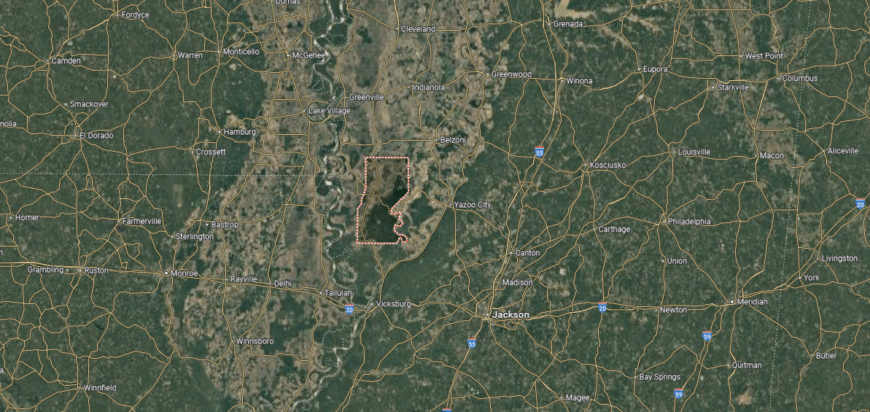
Sharkey County is in the Mississippi Delta region of west-central Mississippi, where flat, fertile farmland dominates the landscape. The county seat, Rolling Fork, sits along U.S. Highway 61 about 40 miles south of Greenville.
The area is bordered by the Yazoo and Sunflower Rivers, with bayous and bottomland forests winding through its fields. With its wide open Delta plains and river lowlands, Sharkey County feels deeply tied to the land and water that surround it.
#10. Bolivar County
– Life expectancy: 68.1 years
— 4.4 years lower than the state average

About
Bolivar County in the Mississippi Delta sustains a broad agricultural economy, with soybeans, rice, cotton, and corn forming the core of production. Cleveland, the county seat, adds strength through higher education, retail, and health care, while other towns support processing and distribution tied to farm output.
Manufacturing and river access along the Mississippi provide further opportunities in trade and industry. With agriculture at its base and industry and services expanding, Bolivar County maintains one of the Delta’s most diverse and resilient economies.
Where is Bolivar County?
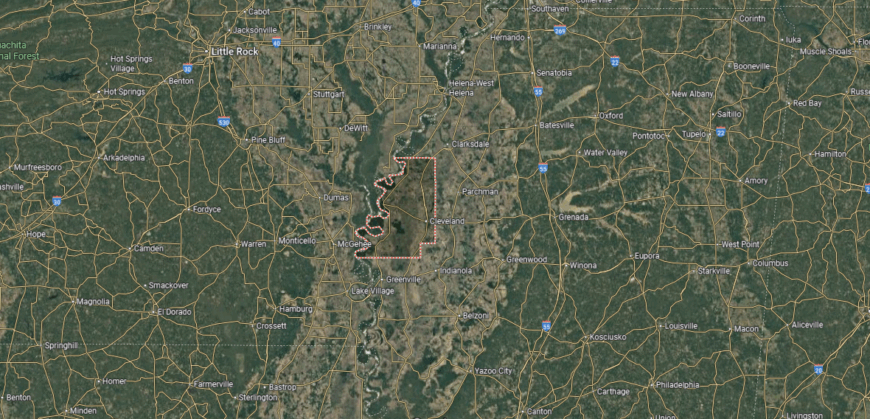
Bolivar County is in the northwestern Mississippi Delta, bordered on the west by the Mississippi River. The county has two seats, Cleveland and Rosedale, connected by U.S. Highway 61, the main north–south route through the Delta.
The land is flat and fertile, dominated by farmland, with the river and levees shaping much of its landscape. With its wide fields and riverfront stretches, Bolivar County sits at the heart of Mississippi’s Delta country.
#9. Sunflower County
– Life expectancy: 67.7 years
— 4.8 years lower than the state average

About
Sunflower County in the heart of the Mississippi Delta is defined by large-scale agriculture, with cotton, soybeans, corn, and rice forming the foundation of its economy. Indianola, the county seat, anchors commerce with retail, health care, and small industries that support the agricultural sector.
The county is also home to correctional facilities and community colleges, which contribute significantly to local employment. With farming, education, and institutional jobs working together, Sunflower County sustains an economy closely tied to both land and services.
Where is Sunflower County?
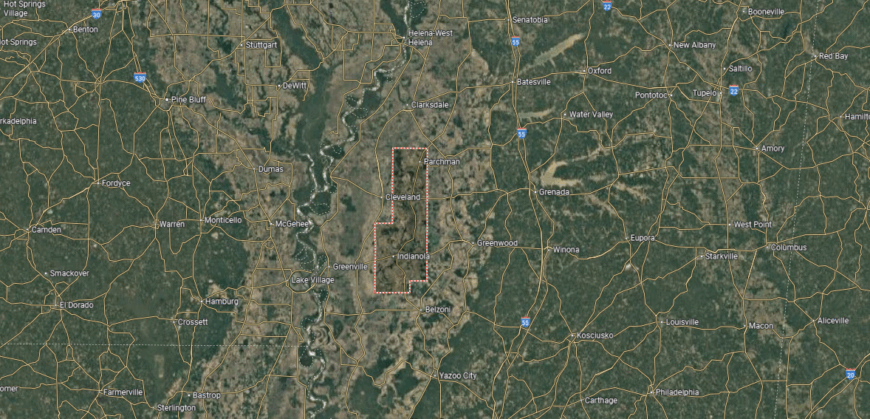
Sunflower County lies in the central Mississippi Delta, where flat, fertile farmland stretches for miles in every direction. The county seat, Indianola, sits along U.S. Highway 82 about 95 miles northwest of Jackson.
Other Delta towns like Ruleville and Moorhead are connected by rural highways that cross bayous, fields, and scattered groves of trees. With its open fields and quiet small towns, Sunflower County feels firmly rooted in the Delta’s wide, agricultural landscape.
#8. Washington County
– Life expectancy: 67.4 years
— 5.1 years lower than the state average

About
Washington County in the Mississippi Delta supports one of the state’s most robust agricultural economies, with soybeans, cotton, rice, and catfish farming leading production. Greenville, the county seat, serves as a major trade and service hub, adding strength through health care, retail, and regional business activity.
Its position along the Mississippi River has long made transportation and distribution vital, supporting both farming and manufacturing. With agriculture, river commerce, and service industries working together, Washington County maintains a diverse and regionally significant economy.
Where is Washington County?
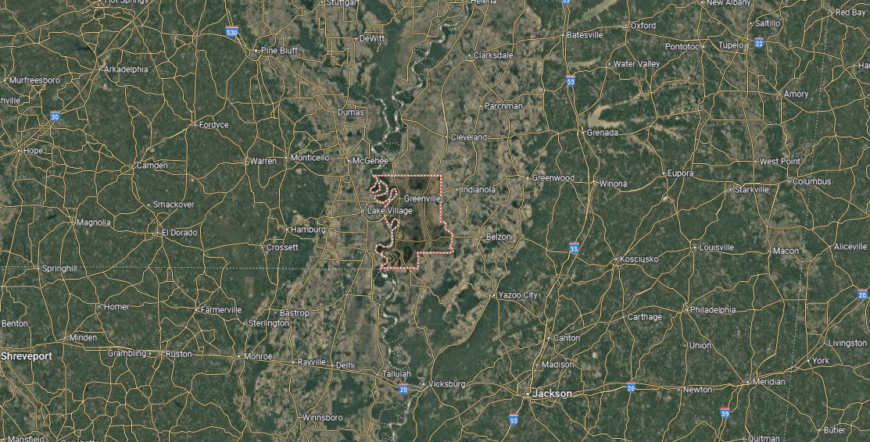
Washington County is in the heart of the Mississippi Delta, bordered on the west by the Mississippi River. The county seat, Greenville, sits along U.S. Highway 82 about 115 miles northwest of Jackson.
The landscape is almost entirely flat, with farmland, levees, and river channels shaping its character. With its riverfront setting and open Delta plains, Washington County feels tied closely to both the land and the water that define the region.
#6. Holmes County (tie)
– Life expectancy: 67.2 years
— 5.3 years lower than the state average

About
Holmes County in central Mississippi has an economy built primarily on agriculture, with soybeans, corn, and cattle forming its base. Lexington, the county seat, supports local trade and small businesses, while nearby towns contribute to agricultural processing and distribution.
Forestry and limited manufacturing add another layer, though farming remains the dominant sector. With its rural character and steady resource use, Holmes County maintains an economy strongly tied to the land while gradually broadening through small industry and trade.
Where is Holmes County?
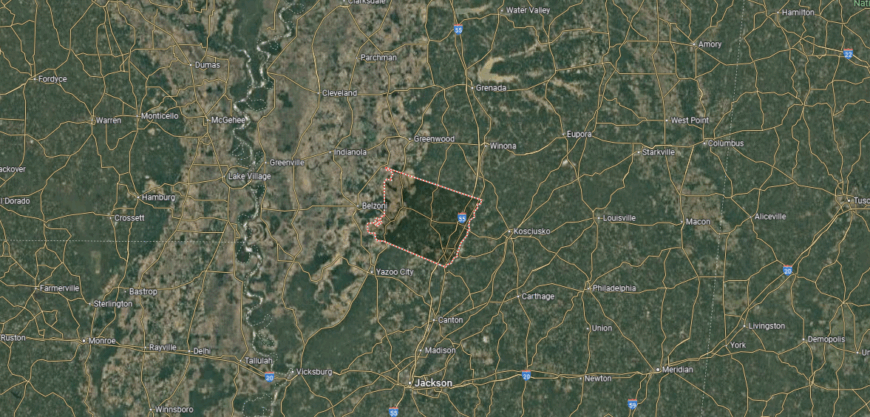
Holmes County is in central Mississippi, where the hills of the interior meet the flatlands of the Delta. The county seat, Lexington, sits along U.S. Highway 49 about 60 miles north of Jackson.
Rural highways and backroads connect small farming communities, forests, and rolling countryside across the county. With its blend of hills, fields, and Delta edge, Holmes County feels like a quiet meeting point between two of Mississippi’s landscapes.
#6. Humphreys County (tie)
– Life expectancy: 67.2 years
— 5.3 years lower than the state average
You may also like: Where people in Mississippi are moving to most

About
Humphreys County in the Mississippi Delta is heavily dependent on agriculture, with catfish farming, soybeans, cotton, and corn shaping its economy. Belzoni, the county seat, is often called the “Catfish Capital,” reflecting the industry’s importance to local production and employment.
While aquaculture dominates, row crops and small industries provide additional support. With farming and fish production at its core, Humphreys County sustains an economy closely tied to Delta resources and specialized agricultural output.
Where is Humphreys County?
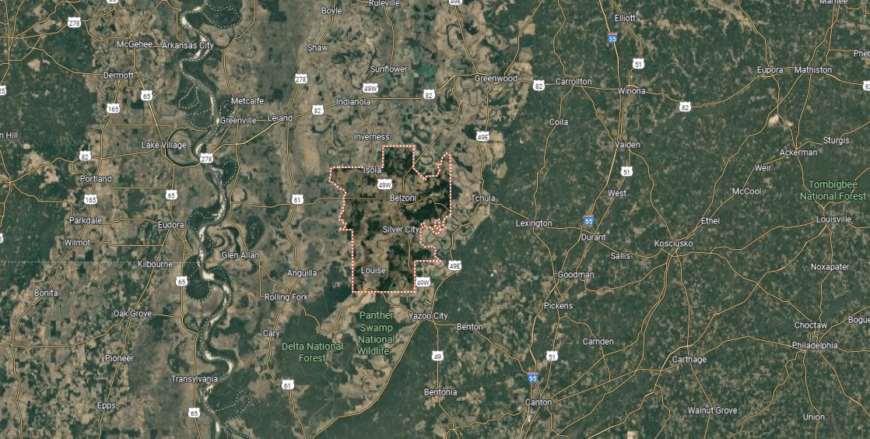
Humphreys County is in the central Mississippi Delta, where flat farmland stretches between rivers and bayous. The county seat, Belzoni, lies along U.S. Highway 49W about 85 miles north of Jackson.
The area is crisscrossed by the Yazoo and Sunflower Rivers, with fields and levees dominating the landscape. With its open Delta plains and winding waterways, Humphreys County feels deeply rooted in the region’s agricultural heart.
#5. Leflore County
– Life expectancy: 67.1 years
— 5.4 years lower than the state average

About
Leflore County in the Mississippi Delta supports an economy strongly tied to agriculture, with cotton, soybeans, rice, and corn remaining central crops. Greenwood, the county seat, serves as a hub for processing, distribution, and retail, linking farm production with regional commerce.
The county also benefits from light manufacturing, health care, and education, which provide stability beyond farming. With its mix of agriculture, services, and industry, Leflore County maintains a diversified economy within the Delta’s farming tradition.
Where is Leflore County?
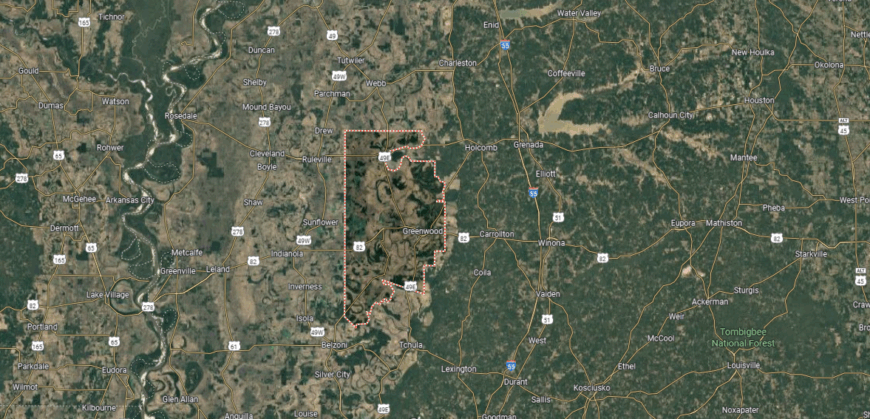
Leflore County is in the central Mississippi Delta, a region of flat, fertile farmland shaped by rivers and bayous. The county seat, Greenwood, sits at the confluence of the Yazoo and Tallahatchie Rivers and is reached by U.S. Highways 49E, 49W, and 82.
The landscape is marked by wide fields, levees, and small Delta communities scattered across the countryside. With its river setting and expansive farmland, Leflore County lies at the core of Mississippi’s Delta country.
#4. Quitman County
– Life expectancy: 67.0 years
— 5.5 years lower than the state average

About
Quitman County in the Mississippi Delta relies on agriculture as its primary economic driver, with cotton, soybeans, and corn dominating production. Marks, the county seat, supports local trade and small industries that connect farm output to regional markets.
While farming remains the backbone, forestry and limited manufacturing contribute additional stability. With agriculture at its center and modest industry supporting it, Quitman County maintains a rural economy closely tied to Delta resources.
Where is Quitman County?
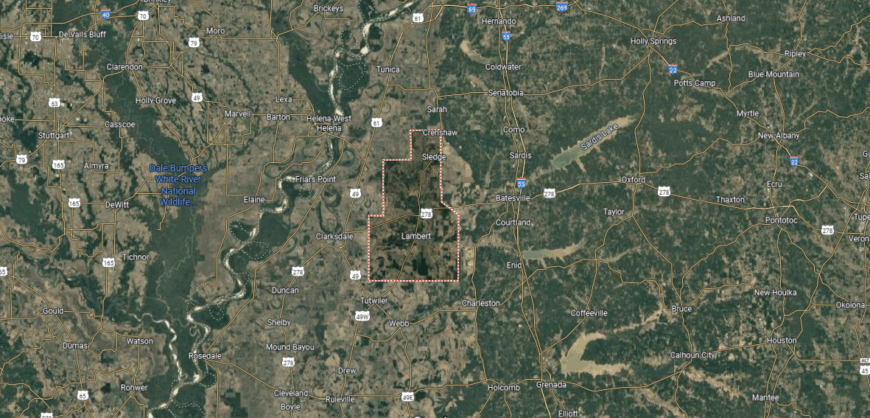
Quitman County is in the northwestern Mississippi Delta, where flat farmland stretches across the landscape. The county seat, Marks, sits along U.S. Highway 278 about 60 miles south of Memphis.
Smaller state highways branch through rural communities, connecting fields, bayous, and levees that shape the region. With its open Delta plains and quiet towns, Quitman County reflects the secluded character of Mississippi’s Delta country.
#3. Neshoba County
– Life expectancy: 66.9 years
— 5.6 years lower than the state average

About
Neshoba County in east-central Mississippi supports a mixed economy of agriculture, manufacturing, and services. Poultry and cattle remain important, while Philadelphia, the county seat, strengthens the area with retail, health care, and small industries tied to food processing.
Tourism also plays a role, with the Choctaw Indian Fair and the Pearl River Resort adding jobs and revenue beyond traditional sectors. With farming, industry, and tourism working together, Neshoba County maintains a balanced and steadily adapting economy.
Where is Neshoba County?

Neshoba County is in east-central Mississippi, where rolling hills and pine forests spread across the landscape. The county seat, Philadelphia, lies about 80 miles northeast of Jackson and is reached by State Highways 15 and 16.
Smaller roads connect rural communities, farmland, and woodland throughout the county. With its hill country setting and quiet countryside, Neshoba County feels like a settled stretch in Mississippi’s interior.
#2. Coahoma County
– Life expectancy: 66.2 years
— 6.3 years lower than the state average

About
Coahoma County in the Mississippi Delta has long relied on agriculture, with cotton, soybeans, corn, and rice forming the base of production. Clarksdale, the county seat, anchors the economy with trade, health care, and small industries that connect farm output to regional markets.
Tourism also plays a growing role, as Clarksdale’s blues heritage attracts visitors from across the world, adding revenue to the service sector. With agriculture at its core and tourism and services expanding, Coahoma County maintains a diverse but land-centered economy.
Where is Coahoma County?
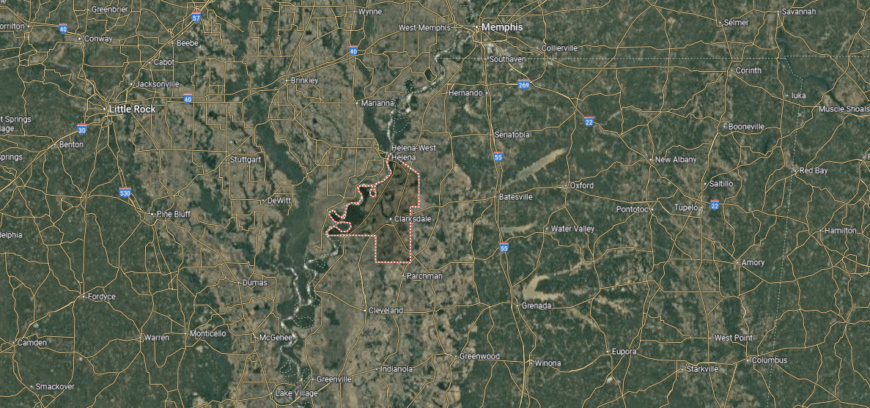
Coahoma County is in the northwestern Mississippi Delta, bordered by the Mississippi River on its western side. The county seat, Clarksdale, lies along U.S. Highways 61 and 49, about 75 miles south of Memphis.
The landscape is flat and fertile, dominated by farmland, bayous, and levees that define the Delta. With its open fields and riverfront stretches, Coahoma County sits at the center of Mississippi’s Delta country.
#1. Tunica County
– Life expectancy: 65.4 years
— 7.1 years lower than the state average
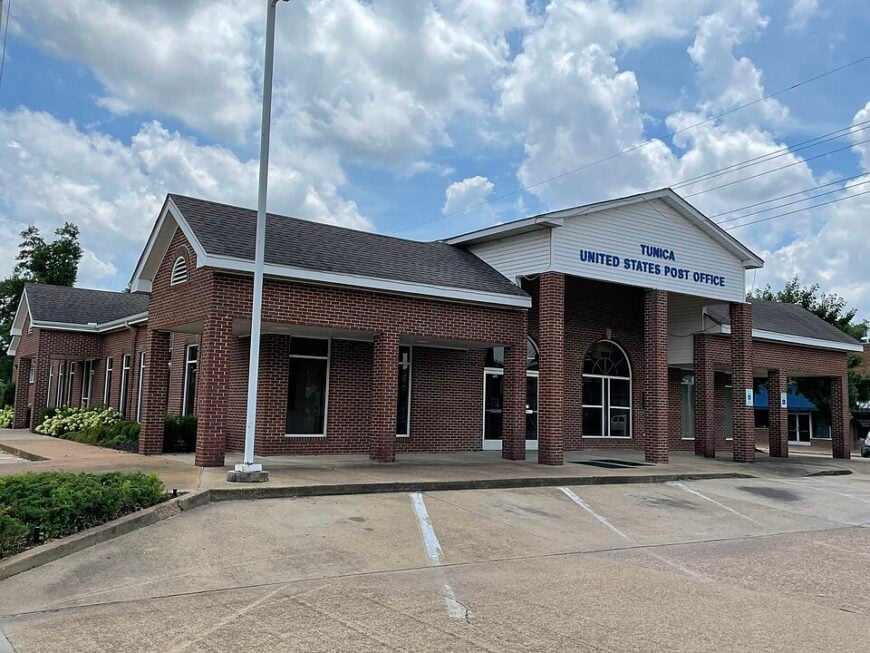
About
Tunica County in northwestern Mississippi has shifted from a primarily agricultural economy to one that includes significant gaming and tourism revenue. Soybeans, cotton, and corn remain important crops, but casinos along the Mississippi River have become major employers and sources of income.
Tunica, the county seat, supports this mix with retail, hospitality, and small industries tied to both farming and tourism. With agriculture, gaming, and services working together, Tunica County sustains one of the more diversified economies in the Delta region.
Where is Tunica County?
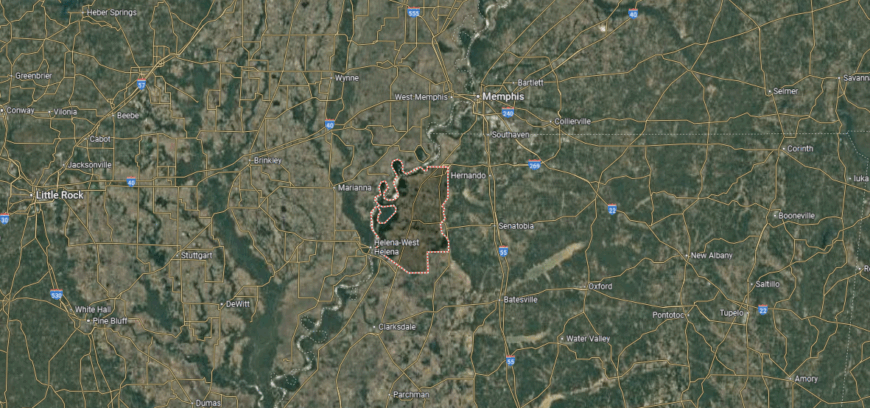
Tunica County is in the northwestern corner of Mississippi, bordered by the Mississippi River and lying within the flat farmland of the Delta. The county seat, Tunica, sits about 30 miles south of Memphis and is reached by U.S. Highway 61. The landscape is dominated by cotton fields, bayous, and levees that stretch across the wide Delta plain. With its river setting and open farmland, Tunica County reflects the quiet character of Mississippi’s Delta region while sitting close to the edge of a major city.
This story features data reporting by Karim Noorani, writing by Kiersten Hickman, and is part of a series utilizing data automation across 49 states.
You may also like: Best colleges in Mississippi
By Stacker





